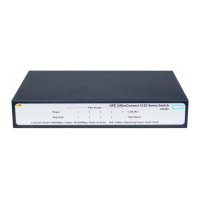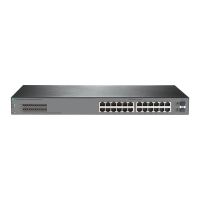161
Parameters
limit: Specifies the BPDU transmission rate in the range of 1 to 255.
Usage guidelines
The maximum number of BPDUs a port can send within each hello time equals the BPDU
transmission rate plus the hello timer value.
A larger BPDU transmission rate value requires more system resources. An appropriate BPDU
transmission rate setting can prevent spanning tree protocols from using excessive bandwidth
resources during network topology changes. As a best practice, use the default value.
If this command is configured in Layer 2 Ethernet interface view, it takes effect only on that interface.
If this command is configured in Layer 2 aggregate interface view, it takes effect only on the
aggregate interface.
If this command is configured on a member port in an aggregation group, it takes effect only after the
port leaves the aggregation group.
Examples
# Set the BPDU transmission rate of GigabitEthernet 1/0/1 to 5.
<Sysname> system-view
[Sysname] interface gigabitethernet 1/0/1
[Sysname-GigabitEthernet1/0/1] stp transmit-limit 5
stp vlan enable
Use stp vlan enable to enable the spanning tree feature for VLANs.
Use
undo stp enable to disable the spanning tree feature for VLANs.
Syntax
stp vlan vlan-id-list enable
undo stp vlan
vlan-id-list enable
Default
The spanning tree feature is enabled in VLANs.
Views
System view
Predefined user roles
network-admin
Parameters
vlan vlan-id-list: Specifies a space-separated list of up to 10 VLAN items. Each item
specifies a VLAN or a range of VLANs in the form of
vlan-id1 [ to vlan-id2 ]. The value for
vlan-id2 must be equal to or greater than the value for vlan-id1. The value range for the
vlan-id argument is 1 to 4094. If you do not specify this option, this command globally enables or
disables the spanning tree feature (VLANs are not included).
Usage guidelines
When you enable the spanning tree feature, the device operates in STP, RSTP, PVST, or MSTP
mode, depending on the spanning tree mode setting.
When you enable the spanning tree feature, the device dynamically maintains the spanning tree
status of VLANs, based on received configuration BPDUs. When you disable the spanning tree
feature, the device stops maintaining the spanning tree status.

